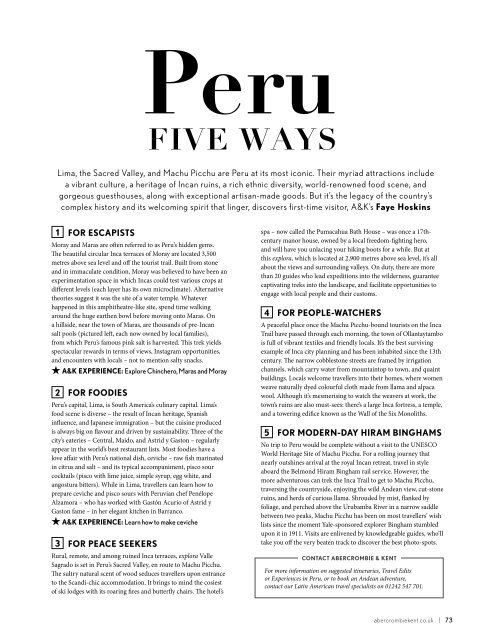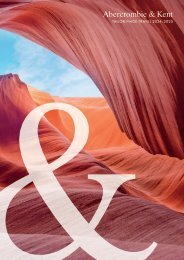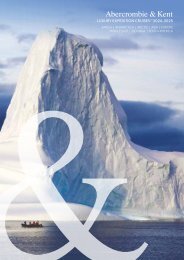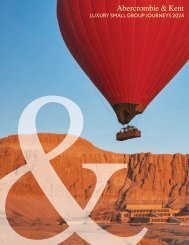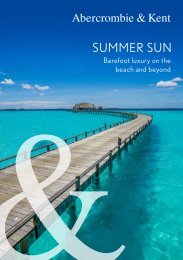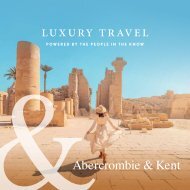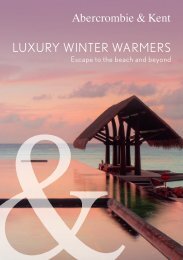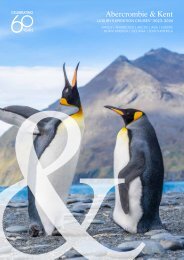Sundowner Magazine: Spring/Summer 2020
Create successful ePaper yourself
Turn your PDF publications into a flip-book with our unique Google optimized e-Paper software.
Peru<br />
FIVE WAYS<br />
Lima, the Sacred Valley, and Machu Picchu are Peru at its most iconic. Their myriad attractions include<br />
a vibrant culture, a heritage of Incan ruins, a rich ethnic diversity, world-renowned food scene, and<br />
gorgeous guesthouses, along with exceptional artisan-made goods. But it’s the legacy of the country’s<br />
complex history and its welcoming spirit that linger, discovers first-time visitor, A&K’s Faye Hoskins<br />
1<br />
FOR ESCAPISTS<br />
Moray and Maras are often referred to as Peru’s hidden gems.<br />
The beautiful circular Inca terraces of Moray are located 3,500<br />
metres above sea level and off the tourist trail. Built from stone<br />
and in immaculate condition, Moray was believed to have been an<br />
experimentation space in which Incas could test various crops at<br />
different levels (each layer has its own microclimate). Alternative<br />
theories suggest it was the site of a water temple. Whatever<br />
happened in this amphitheatre-like site, spend time walking<br />
around the huge earthen bowl before moving onto Maras. On<br />
a hillside, near the town of Maras, are thousands of pre-Incan<br />
salt pools (pictured left, each now owned by local families),<br />
from which Peru’s famous pink salt is harvested. This trek yields<br />
spectacular rewards in terms of views, Instagram opportunities,<br />
and encounters with locals – not to mention salty snacks.<br />
2<br />
A&K EXPERIENCE: Explore Chinchero, Maras and Moray<br />
FOR FOODIES<br />
Peru’s capital, Lima, is South America’s culinary capital. Lima’s<br />
food scene is diverse – the result of Incan heritage, Spanish<br />
influence, and Japanese immigration – but the cuisine produced<br />
is always big on flavour and driven by sustainability. Three of the<br />
city’s eateries – Central, Maido, and Astrid y Gaston – regularly<br />
appear in the world’s best restaurant lists. Most foodies have a<br />
love affair with Peru’s national dish, ceviche – raw fish marinated<br />
in citrus and salt – and its typical accompaniment, pisco sour<br />
cocktails (pisco with lime juice, simple syrup, egg white, and<br />
angostura bitters). While in Lima, travellers can learn how to<br />
prepare ceviche and pisco sours with Peruvian chef Penélope<br />
Alzamora – who has worked with Gastón Acurio of Astrid y<br />
Gaston fame – in her elegant kitchen in Barranco.<br />
3<br />
A&K EXPERIENCE: Learn how to make ceviche<br />
FOR PEACE SEEKERS<br />
Rural, remote, and among ruined Inca terraces, explora Valle<br />
Sagrado is set in Peru’s Sacred Valley, en route to Machu Picchu.<br />
The sultry natural scent of wood seduces travellers upon entrance<br />
to the Scandi-chic accommodation. It brings to mind the cosiest<br />
of ski lodges with its roaring fires and butterfly chairs. The hotel’s<br />
spa – now called the Pumacahua Bath House – was once a 17thcentury<br />
manor house, owned by a local freedom-fighting hero,<br />
and will have you unlacing your hiking boots for a while. But at<br />
this explora, which is located at 2,900 metres above sea level, it’s all<br />
about the views and surrounding valleys. On duty, there are more<br />
than 20 guides who lead expeditions into the wilderness, guarantee<br />
captivating treks into the landscape, and facilitate opportunities to<br />
engage with local people and their customs.<br />
4<br />
FOR PEOPLE-WATCHERS<br />
A peaceful place once the Machu Picchu-bound tourists on the Inca<br />
Trail have passed through each morning, the town of Ollantaytambo<br />
is full of vibrant textiles and friendly locals. It’s the best surviving<br />
example of Inca city planning and has been inhabited since the 13th<br />
century. The narrow cobblestone streets are framed by irrigation<br />
channels, which carry water from mountaintop to town, and quaint<br />
buildings. Locals welcome travellers into their homes, where women<br />
weave naturally dyed colourful cloth made from llama and alpaca<br />
wool. Although it’s mesmerising to watch the weavers at work, the<br />
town’s ruins are also must-sees: there’s a large Inca fortress, a temple,<br />
and a towering edifice known as the Wall of the Six Monoliths.<br />
5<br />
FOR MODERN-DAY HIRAM BINGHAMS<br />
No trip to Peru would be complete without a visit to the UNESCO<br />
World Heritage Site of Machu Picchu. For a rolling journey that<br />
nearly outshines arrival at the royal Incan retreat, travel in style<br />
aboard the Belmond Hiram Bingham rail service. However, the<br />
more adventurous can trek the Inca Trail to get to Machu Picchu,<br />
traversing the countryside, enjoying the wild Andean view, cut-stone<br />
ruins, and herds of curious llama. Shrouded by mist, flanked by<br />
foliage, and perched above the Urubamba River in a narrow saddle<br />
between two peaks, Machu Picchu has been on most travellers’ wish<br />
lists since the moment Yale-sponsored explorer Bingham stumbled<br />
upon it in 1911. Visits are enlivened by knowledgeable guides, who’ll<br />
take you off the very beaten track to discover the best photo-spots.<br />
CONTACT ABERCROMBIE & KENT<br />
For more information on suggested itineraries, Travel Edits<br />
or Experiences in Peru, or to book an Andean adventure,<br />
contact our Latin American travel specialists on 01242 547 701.<br />
abercrombiekent.co.uk | 73


